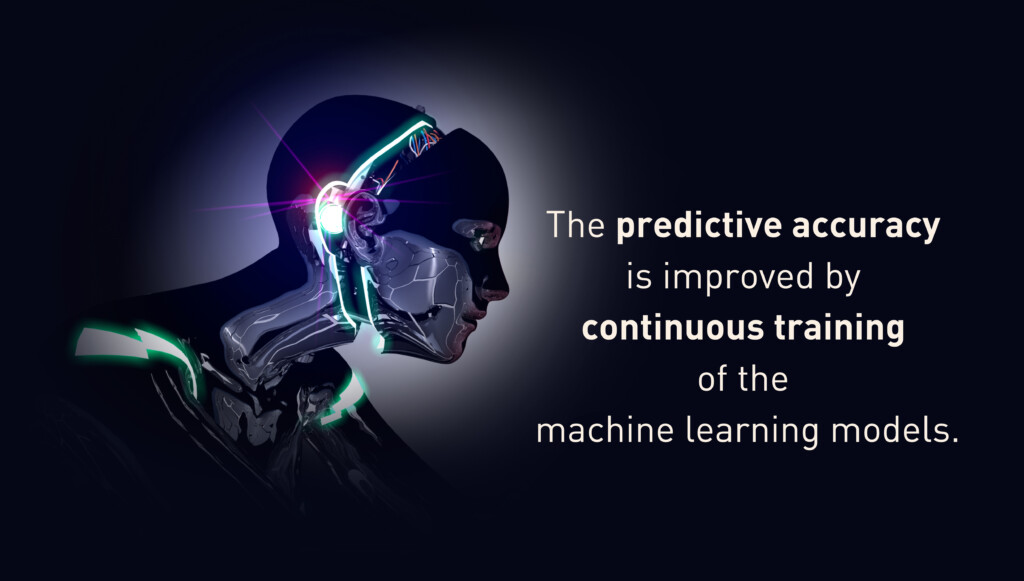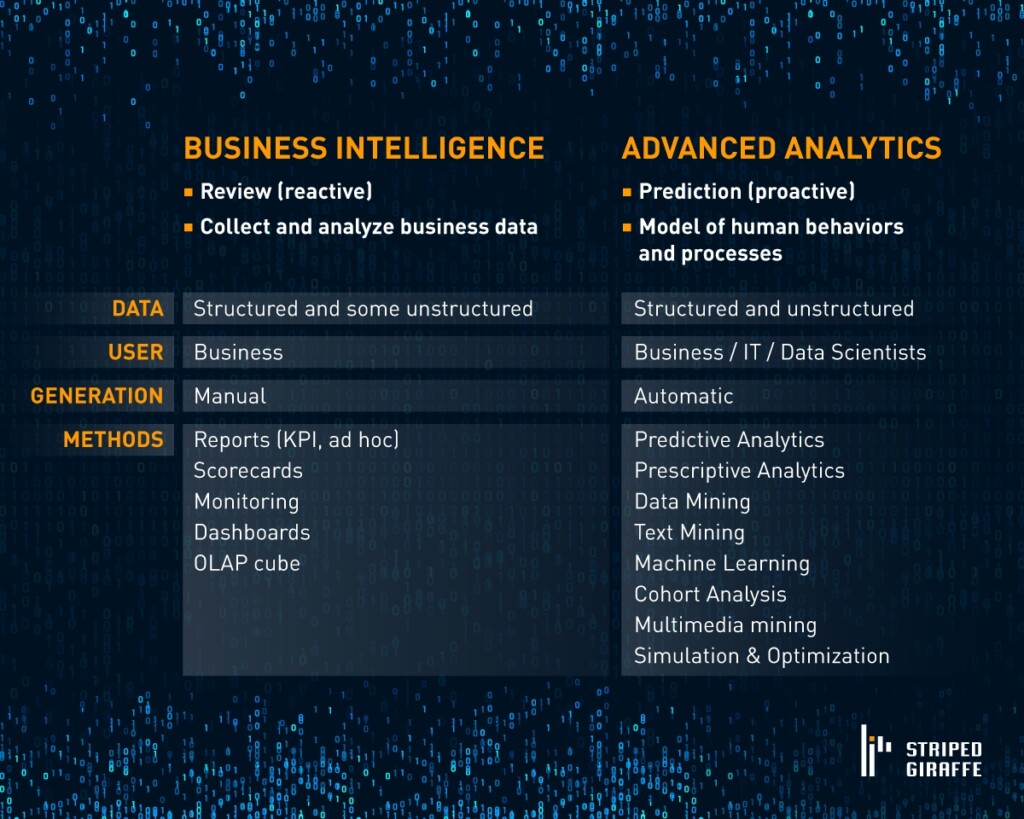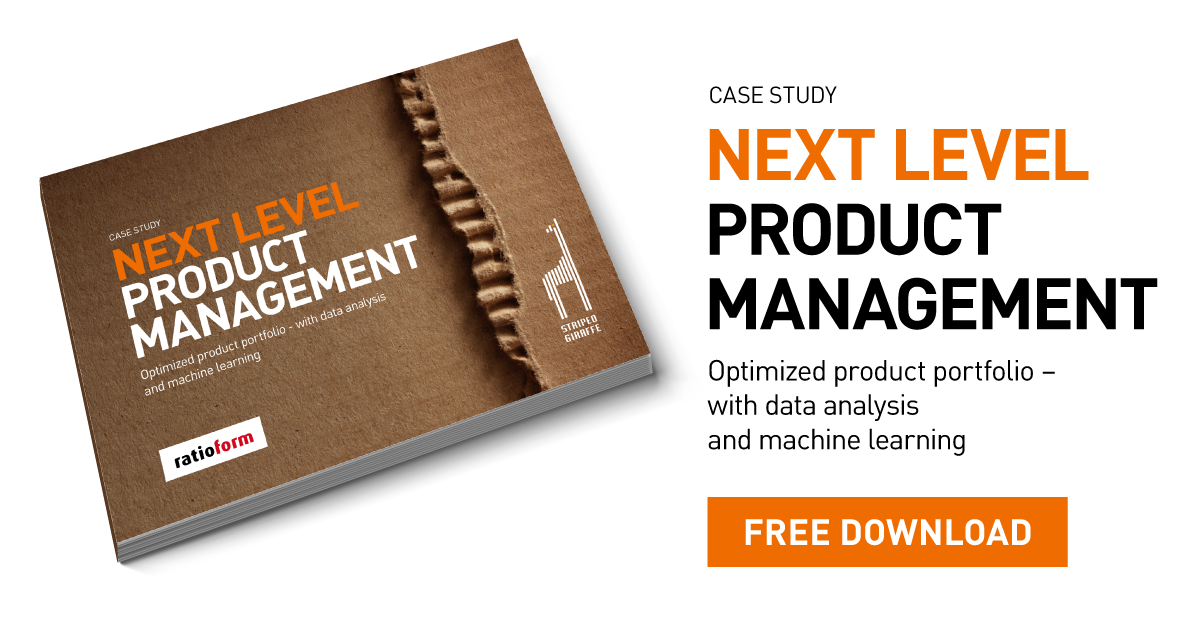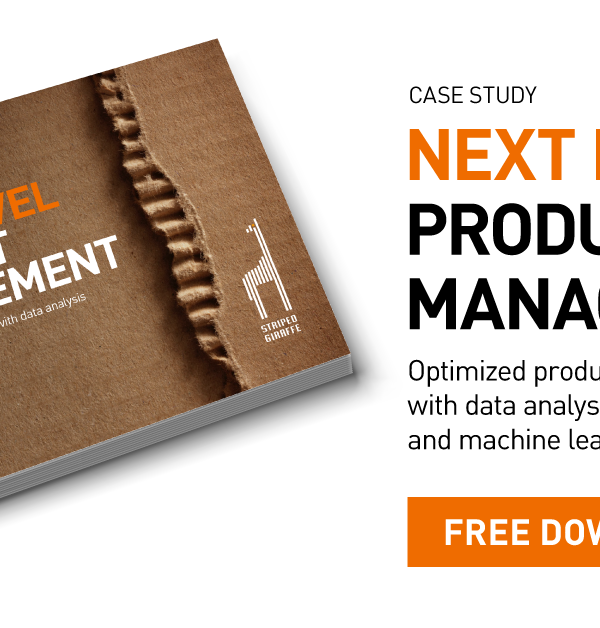
What is Advanced Analytics and why is it so important for companies?
Advanced Analytics refers to a collection of different tools for the analysis of structured and unstructured data that allows the prediction of future events.
In this way, Advanced Analytics differs significantly from Business Intelligence (BI), which is mainly focused on the analysis of historical data and events and thus explains why certain occurrences took place in the past. In the era of Big Data, the consistent use of Big Data analytics opens up potential competitive advantages for companies.
In general, Advanced Analytics goes beyond classical Business Intelligence approaches and can be used to cover the following fields:
- Segmentation refers to the grouping of objects based on similarities
- Classification of unclassified elements according to common properties
- Correlation stands for the identification of mutual relationships between the properties of elements
- Forecasting to derive future values
- Association refers to the identification of the frequency of common occurrence and the deduction from the rule
Different approaches are distinguished, which are applied depending on the given scenario. In the following, we will briefly outline them.
Predictive Analytics
Predictive analytics is a forward-looking analysis approach that aims to make predictions of what is likely to happen in the future. This provides management with valuable insights to make future business decisions on a sound basis. In order to make such a prediction, predictive analytics uses statistical models which, based on historical data and including other external data sources, allow conclusions to be made about business development in the future, demand for specific products or product groups, or anticipated maintenance expenses and wear and tear on machines, vehicles or production equipment, for instance.
Leading vehicle manufacturers, for example, already rely on predictive analytics to provide individually tailored, optimal maintenance and service advice based on the operating and environmental parameters under which their vehicles are used.
Prescriptive Analytics
Prescriptive analytics is the combination of predictive analytics methods with elements from the Business Intelligence environment. These methods are particularly suitable for finding promising solutions to existing business challenges. Prescriptive analytics helps decision-makers to select the best alternative course of action to achieve their goals.
Machine Learning
Machine learning is a subarea of artificial intelligence, or AI for short, and has become very popular for some years now. Machine learning methods enable computer systems to recognize patterns and regularities in data sets and to use them by means of complex algorithms to analyze specific events or to predict future ones. In doing so, these solutions generate their “knowledge” from previously made experiences and historical data. Machine learning also combines various tools, such as deep learning, which uses neural networks to map complex internal structures, attempting to replicate the way the human brain works.
The variety of data that machine learning solutions can process is immense, as almost every conceivable form of digitally stored data can be used. This also includes images, for example. After careful selection, the machine learning models used are continually trained to improve the accuracy of their predictions.

Data Mining
Strictly speaking, data mining is not a dedicated analysis method. It is used to identify relationships and dependencies as well as sequences and anomalies in large raw data sets. Usually, statistical applications are also used and the goal is always to extract information from data and transform it into a structure that can then be used further.
Cluster-Analysis
Cluster analysis is an important method of data mining. It is used to analyze large data sets with regard to similar structures. Data is analyzed according to its similarity to each other. Similar objects are then grouped together in clusters. The results of cluster analysis can be displayed graphically quite easily.
Cohort Analysis
Cohort analysis is a subset of behavioral analysis. It involves observing and analyzing the behavior of a few people in a group in order to draw conclusions that apply to the entire group. People in this context are, for example, users or customers. In terms of data, cohort analysis looks at only a portion of a large dataset over a given period of time. Therefore, the entirety of the data is divided into smaller datasets according to given attributes, and then the analysis is started on the basis of this smaller set, which has already been selected according to its relevance.
Data Science
Data Science is the discipline of examining structured and unstructured data, such as a huge data lake, for useful information and insights. From the information gained, data scientists derive recommendations for action to sustainably increase your business success. To do this, they draw on a wide range of different methods, processes, and tools. These include the analysis methods described above.
Data Scientists not only focus on the database but are also able to analyze it on the basis of their business know-how with a view to complex business contexts. The role of Data Science is therefore one of the areas in digital companies that is currently gaining the most importance. It is instrumental in asking the right questions in order to gain truly valuable insights from big data.
Advanced Analytics Solutions
Within the last few years, countless providers have developed Advanced Analytics solutions. The market offers a wide variety of solutions for a multitude of challenges. It is therefore not possible to make a general statement about which tools and processes meet the individual requirements of a customer without a thorough analysis.
In principle, corresponding projects can be implemented very well iteratively. After a precise analysis of the requirements, a pre-selection of suitable models should be made and, in the next step, it should be determined whether the available data have enough predictive power. At the same time, the effectiveness of the selected models can be checked before they are trained at great expense. In this way, the use of individual methods can be tested and ultimately implemented in a relatively cost-efficient manner.
Benefits of Advanced Analytics
The data analytics methods described above allow you to analyze an ever-increasing amount of data more quickly, gain insights, and make better business decisions based on them.
Using Advanced Analytics for precise decisions
Advanced Analytics gives users deep insights into their data and helps them gain profound insights. Unlike intuition or an experience-based decision-making approach, Advanced Analytics’ data-driven approach makes predictions based on facts, guiding you to the alternative action with the highest expected benefit.
Personalization in Sales & Marketing
Advanced Analytics tools enable patterns to be identified even from less aggregated data sets. So, for example, instead of simply inferring the demand of an entire customer segment and offering the same favorite products to all customers in that segment, Advanced Analytics methods allow you to capture personal preferences all the way down to the individual customer. Using agile architectural approaches, different data sources can be integrated to provide a more complete picture of the customer, offering them an entirely new customer experience. The right analytics models can significantly increase both the effectiveness of marketing initiatives and the satisfaction of your customers.
More time for strategically important initiatives
Choosing the right Advanced Analytics methods allows you to reduce the effort required for data analysis, enabling you to spend valuable resources on more important tasks. Large volumes of data can be analyzed quickly and efficiently, enabling insights to be gained in the shortest possible time, allowing companies to make decisions in the short term. Analysts are thus available for other exciting projects. This gives management the time to focus on strategic initiatives for the sustainable development and optimization of their business processes.
Achieve better ROI through Advanced Analytics
Advanced Analytics tools enable companies to effectively decide where and when to deploy resources. This reduces costs and increases efficiency. Furthermore, Advanced Analytics identifies customer needs so that products and services can be further developed in line with target groups and innovations can be placed on the market ahead of the competition.
Data Sharing
Using Advanced Analytics tools supports data integration initiatives and enables secure data sharing across the enterprise. When data is accessible to employees, they are able to identify and act on opportunities early – contributing to the success of the business in a sustainable way.
Use Cases for Advanced Analytics
If traditional Business Intelligence methods have already been implemented, the introduction of the first Advanced Analytics tools is the next logical step. However, solid data integration is the minimum prerequisite to start a corresponding initiative. The implementation of a modern data warehouse, in the cloud or on-premise, is generally a good starting point. Almost all industries and business areas can benefit from consistent use of appropriate methods and processes.
Machine Learning powered product management
Machine learning technologies can be used in product management to make precise predictions about the future development and performance of individual products along their lifecycle.
A leading packaging supplier has discovered this and had a Product Lifecycle Advisor developed based on Machine Learning. The solution enables product managers to gain deep insights into their portfolio and identify areas where action is needed for individual products in real-time. This enables them to manage their entire product portfolio of over 8,000 items with a team of 6 product managers.
Customer Churn Detection
In the area of customer satisfaction and churn analysis, Advanced Analytics solutions make an important contribution to gaining deep insights into one’s own customer base and being able to react at an early stage if necessary. Special models analyze in detail various aspects of customer behavior on the one hand and sales on the other, in order to be able to point out imminent changes in good time. Customer Churn Prediction goes beyond mere analysis and even enables the prediction of the impact of future decisions on customer satisfaction. These solutions can be used in combination with various communication and marketing tools, for example, to automatically accommodate customers with appropriate email communications.
There is a supplier of business and office equipment in southern Germany for whom such a solution is making a lasting contribution to positive business development by enabling him to respond quickly and accurately to negative trends.
Shopping Cart Templates
By using individual Advanced Analytics methods to analyze the buying behavior of individuals, retailers can prepare precise suggestions for their customers. In the case of an office equipment retailer, suggestions for adjustable, individual shopping carts are generated for customers. This can both sustainably improve the customer experience and derive positive effects on business development.
Competitive advantages for the financial industry due to Advanced Analytics
Financial institutions and fintechs face constant international competition. In order to stand their ground here, they must serve their customers in the best possible way and at the same time meet high regulatory requirements. Advanced Analytics provides valuable insights to align the financial industry for sustainable competitiveness. For example, an analysis of data on customer behavior can be used to determine the optimal location for self-service terminals or ATMs.

Risks in the lending business can be better assessed. In addition, more accurate risk profiles of potential borrowers can be generated. As a result, risks and fraud incidents are identified at an early stage and efficiently reduced. In particular, the consistent monitoring of usage data based on all six dimensions of data quality helps to minimize compliance risks in the long term. Data analytics also enables regulatory inquiries to be answered quickly and accurately.





